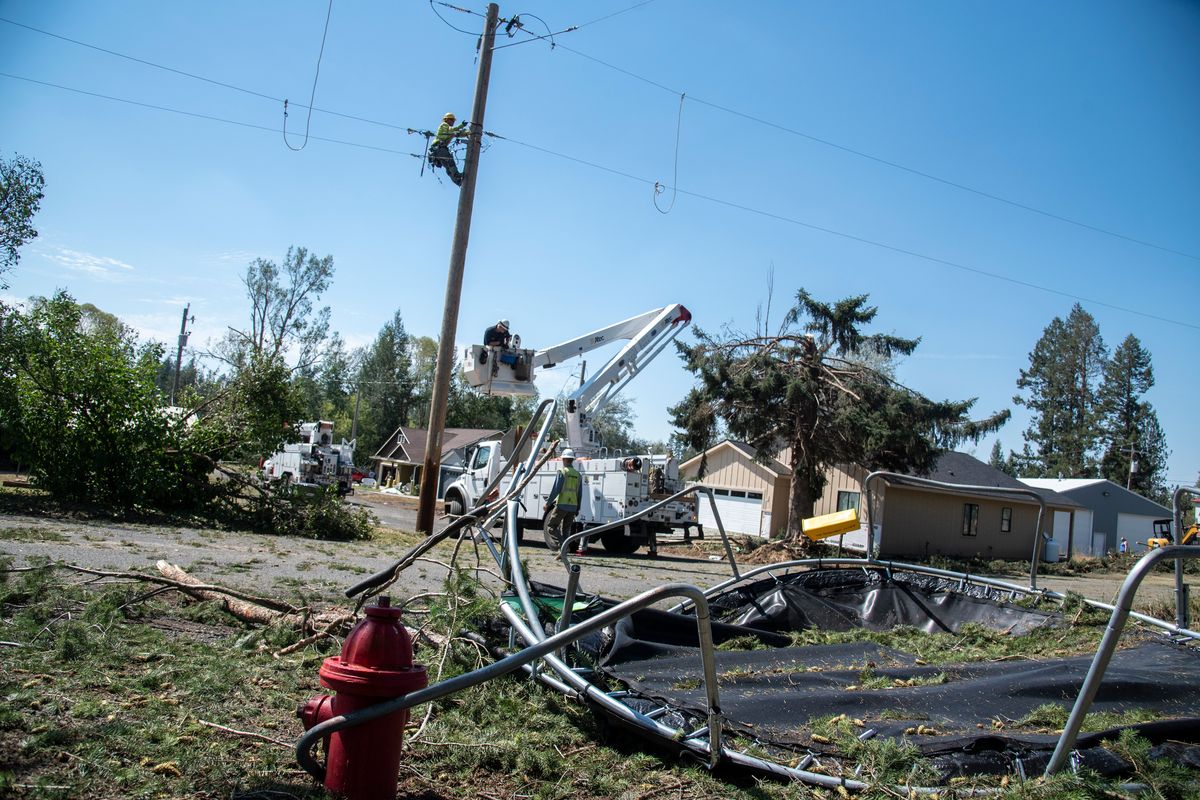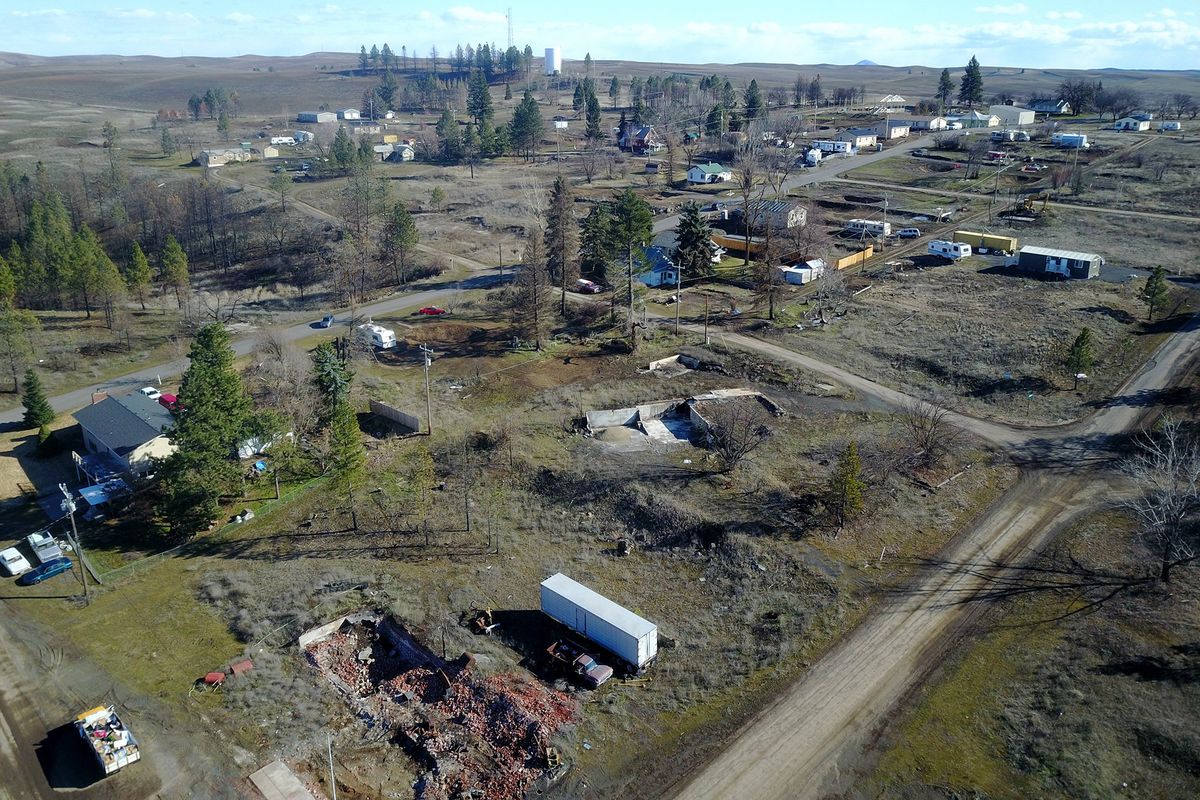Avista to begin blackouts during storms to avoid fires
Malden, shown in March 2022, was devastated by the Babb Road fire on Sept. 7, 2020. The blaze was reportedly caused by a tree falling into an Avista Utilities power line. (Jesse Tinsley/The Spokesman-Review)Buy a print of this photo
Rolling blackouts will now be part of the plan to combat Spokane area wildfires, according to an announcement Tuesday by officials at Avista Utilities.
Company leaders, along with Spokane Mayor Lisa Brown and other local officials, announced the plan following years of upgrading electrical infrastructure for the 416,000 electrical customers it serves in four states.
The new directive follows devastation wrought by the Oregon Road fire near Elk and the Gray fire near Medical Lake that burned a combined 21,000 acres on the same day last summer and destroyed 366 homes.
“We need to be ready for anything, and safety is guiding our plans,” said Heather Rosentrater, Avista president and chief operating officer. “So, in response to the increasing risks related to wildfire in our region, as of this year, Avista is adding public-safety power shutoffs … as a tool of last resort.”
The shutoffs would be used only during summer when fire conditions become the most dangerous, and Avista would use forecasts to give alerts that start with a “watch” as much as a week out, changing to a “warning” within a couple days and an “imminent” announcement if utility mangers plan to cut power.
“It means that if we see conditions that are very extreme, we might preemptively turn off power to select areas of our system,” Rosentrater said. “This is not a decision that we take lightly.”
Brown spoke in support of the plan at the news event, which was held at Avista headquarters at 1411 E. Mission Ave.
“Partnership is the key to the prevention of very serious loss of life and property,” Brown said. “As wildfire season approaches, preparation and mitigation become paramount. And doing so requires the work of all of us at the city and our partners.”
Cheney Fire Chief Tom Jenkins, who also serves as the chair of the Inland Empire Fire Chief’s Association, said such decisions are never easy.
He noted that Predictive Services at the National Interagency Fire Center ranks northeast Washington in its top 10 most hazardous places to live because of the danger of large wildland fires.
“That’s not new information for us fire chiefs that live in this area,” Jenkins said. “What we witnessed last year with the Gray and Oregon Road fires was just a precursor and a testament to what those predictive services have been predicting for quite some time.”
Jenkins noted that residents in Spokane may wonder why they have to pay more for electricity each month to fund upgrades to the system that mostly benefits those who choose to live in rural and forested areas.
“We all pay for the price of not doing our part to help mitigate and manage wildland fires,” he said. “Everyone needs to do their part to help tame the dragon that has no bias.”
Jenkins, who said area chiefs are advocating for more stringent building codes in areas with heightened fire danger, said the victims of the 2023 fire season continue to struggle to recover.
“We’re starting to see a paradigm shift with our insurance carriers, especially on the heels of the worst, most devastating wildland fire season we’ve seen in Spokane history,” Jenkins said. “Pay me now, or pay me later.”
Asked whether the new policy of blackouts may increase the willingness of insurance companies to offer policies at the same time they are raising rates or dropping customers in or near the recent fires, Rosentrater said it was too early to predict.
“I don’t think that’s something we’ve specifically explored at this time,” she said. “And yes, absolutely, risk management for all of our activities as a utility is something that’s core to us. We are a company of continuous improvement.
“And so recognizing that as the risks are increasing, we need to respond appropriately.”
And managing those risks always comes with a cost.
Avista began issuing its “Wildfire Resiliency” plan in 2020.
It included myriad changes, including upgrading wooden poles with steel alternatives, removing vegetation and using circuits that shut down during a failure rather than continuing to push electricity through the lines after they have been compromised.
Avista’s view on using rolling blackouts evolved rather quickly. The 2020 resiliency plan mentioned the 2018 Camp Fire near Paradise, California, that burned more than 18,000 homes and killed 85 people.
“Though Avista is closely monitoring the situation in California and continues to work closely with utility peers … at this time Avista does not plan to pre-emptively shut off power to mitigate risk of wildfire,” the company wrote in May 2020.
Just three months later on September 7, limbs from a pine tree made contact with an Avista Utilities power line on the southern edge of Spokane County, apparently sparking the Babb Road Fire, which raced through nearly 15 miles of dry brush and timber during an intense windstorm, destroying the vast majority of homes in Malden and Pine City.
In the 2023 wildfire resiliency plan, company officials wrote that the utility has been reviewing how other companies have implemented the preventative blackouts. It noted that it could cost Avista customers $21 million to $57 million a year to start the blackouts in its service area.
Asked about that cost Tuesday, Rosentrater said she doubted those figures. She said the bulk of the effort will entail contacting customers to inform them and get contact information, especially for vulnerable residents who rely on electricity for medical equipment.
Avista later clarified that it’s expected to cost between $1 million to $3 million per year to manage the blackouts.
Rosentrater also said that the blackouts may not affect all of the customers, who are spread throughout Eastern Washington, north Idaho and parts of southern and eastern Oregon. It also owns a subsidiary in Alaska.
“We can identify the risk on a by-circuit basis, and even a mile-by-mile basis on those circuits,” she said. “And so, if the weather does become extreme to the point that we would need to call a public safety power shutoff, we want to minimize the number of customers that are impacted by that.”
Restoring power after a shutdown could also take time, she noted.
“We do have to patrol the circuit before we can re-energize … and make sure it’s safe before we restore” power, Rosentrater said. “So, it could be anywhere from several hours, and potentially, several days depending on the length of that circuit and how much damage actually occurred.
“And our plan would be to continue to keep our customers updated as we understand the situation better.”
Spokesman-Review reporter Tod Stephens contributed to this report.
Tom Clouse can be reached at (509) 459-5495 or at tomc@spokesman.com.



